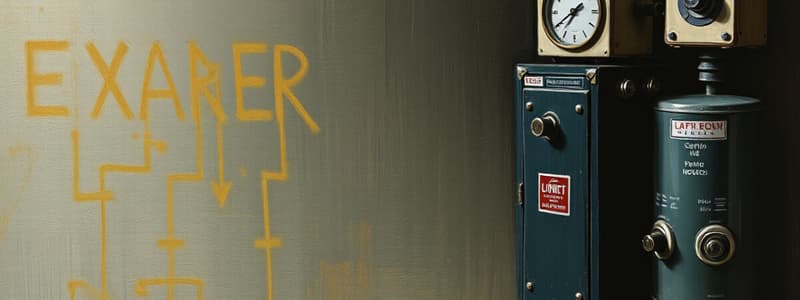Podcast
Questions and Answers
What does the amplitude of a transverse wave represent?
What does the amplitude of a transverse wave represent?
- The distance from the maximum disturbance to the undisturbed position (correct)
- The number of complete waves passing a fixed point
- The distance between the crest and trough
- The time taken for one complete cycle
Which of the following statements about atoms is correct?
Which of the following statements about atoms is correct?
- All atoms have the same electronic structure.
- Protons have a positive charge and neutrons have no charge. (correct)
- Atoms can never form compounds.
- Atoms with a full outer shell are unstable.
How are mixtures distinct from compounds?
How are mixtures distinct from compounds?
- Mixtures can be separated into their individual components. (correct)
- Mixtures have a fixed composition.
- Mixtures consist of chemically combined elements.
- Mixtures can only contain elements of the same type.
Which description correctly defines the term 'wavelength'?
Which description correctly defines the term 'wavelength'?
Which of the following describes rarefaction in a longitudinal wave?
Which of the following describes rarefaction in a longitudinal wave?
What are the three essential parts of an electrical circuit?
What are the three essential parts of an electrical circuit?
How is current in a circuit measured?
How is current in a circuit measured?
What happens to the current when a load is added to a series circuit?
What happens to the current when a load is added to a series circuit?
What is the effect of adding more loops in a parallel circuit?
What is the effect of adding more loops in a parallel circuit?
What is a characteristic of a circuit in series when one component breaks?
What is a characteristic of a circuit in series when one component breaks?
Which of the following materials would likely have low resistance?
Which of the following materials would likely have low resistance?
How do transverse waves differ from longitudinal waves?
How do transverse waves differ from longitudinal waves?
What does frequency measure in the context of waves?
What does frequency measure in the context of waves?
Flashcards are hidden until you start studying
Study Notes
Electrical Circuits
- Essential components include a power supply (battery), conducting path (wires), and load (converts electrical energy).
- Current measures the flow of electrical charge, quantified in Amperes with an ammeter, flowing from positive to negative terminal.
- Voltage is the force pushing electrons, measured in Volts with a voltmeter, and energy is used as electrons travel around the circuit.
- Resistance represents the difficulty for electrons to flow, measured in Ohms; higher resistance means harder flow.
- Conductors (e.g., metals) have low resistance; insulators have high resistance.
Series Circuits
- Current remains constant at all points within a series circuit.
- Adding loads increases total resistance, reducing current flow.
- Total voltage across the power supply equals the sum of voltages across components; adding loads decreases voltage.
- Failure of one component halts the entire circuit.
Parallel Circuits
- Adding more loops in a parallel circuit decreases overall resistance, allowing more current from the power supply.
- Current divides at branches, with reconnection downstream, enabling continued function if one component fails.
Heat Transfer
- Convection is heat transfer through movement of liquids or gases; heated substances become less dense and rise.
Waves
- Two main wave types: longitudinal (energy parallel to wave direction) and transverse (energy perpendicular to wave direction).
- Frequency, measured in hertz, indicates complete waves passing a point over time.
- Period, measured in seconds, represents time for one complete wave cycle.
- Wavelength is the distance between equivalent points on consecutive waves, measured in meters.
- Amplitude measures disturbance height from undisturbed position on transverse waves.
- Trough is the wave's lowest point; crest is the highest point.
- Compression in longitudinal waves occurs where particles are closest; rarefaction is where particles are farthest apart.
Atoms
- Atoms constitute all matter, consisting of three subatomic particles: protons (positive), neutrons (neutral), and electrons (negative).
- Elements differ in atomic structure and are organized in the periodic table by electronic structure, groups, and periods.
- Atoms with 1 or 7 outer electrons are highly reactive; noble gases with full outer shells are stable.
- Elements chemically combine to form compounds (e.g., H2O, CO2), which cannot be separated.
- Mixtures can coexist without chemical bonding and can be separated into individual elements or compounds.
Studying That Suits You
Use AI to generate personalized quizzes and flashcards to suit your learning preferences.




